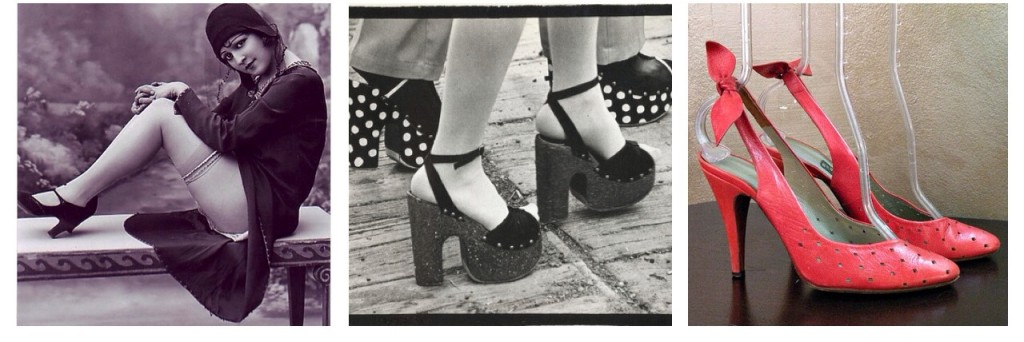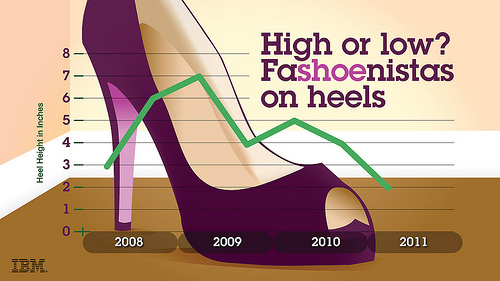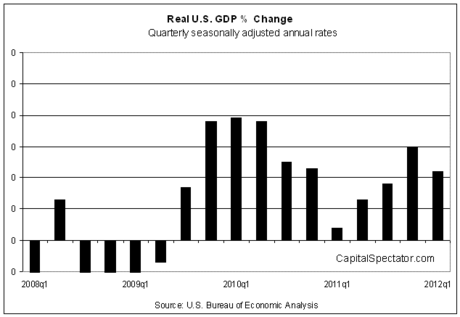 As the world-class luxury shoes designer Jimmy Choo said: “the right shoe can make everything different”. It seems the high heels now are not just women’s “last touch of elegance” (quoted of legend designer Coco Chanel), but also the weapons women are using to fight against the economy recessions.
As the world-class luxury shoes designer Jimmy Choo said: “the right shoe can make everything different”. It seems the high heels now are not just women’s “last touch of elegance” (quoted of legend designer Coco Chanel), but also the weapons women are using to fight against the economy recessions.
IBM conducted a computer-based analysis project on billions of social media posts about about shoe trends, heels are about to go down. The report came out at 2011. In the report, the researchers claimed that the higher the heels, the worse off the Economy would be.
“Usually, in an economic downturn, heels go up and stay up – as consumers turn to more flamboyant fashions as a means of fantasy and escape,” said Dr. Trevor Davis, a consumer products expert with IBM Global Business Services. “This time, something different is happening — perhaps a mood of long term austerity is evolving among consumers sparking a desire to reduce ostentation in everyday settings.”
According to an article published by the Christian Science Monitor from CNBC wire, the several big recessions of the U.S. Economy in history have shown the correlation between the economy status and the height of the heels.
In the 1920s, women were wearing high-heel pumps and platforms to get their confidence back during the Great Depression. In the 1970s oil crisis, platforms came back en vogue as the low-heeled sandals of the late 1960s were cast aside. In the 1990s, the low, thick heels of the “grunge” period were replaced by “Sex and the City”-inspired stilettos just as the dot-com bubble burst.
From left to right: wall deco in 1920s; the popular platform shoes in 1970s; vintage stilettos from 1990s.
From the report published in 2011, an analysis of the four years (from 2008 to 2011) of social media showed that discussions of increasing heel height peaked towards the end of 2009, and declined after that. For example, key trend-watching bloggers between 2008 and 2009 wrote consistently about heels from five to eight inches, but by mid 2011 they were writing about the return of the “the perfect flat”. The sky-high heels were not gone yet; rather that, as the economy has bounced back a little, the bloggers were discussing as glamwear and not for the office or shopping trip.
Source: IBM
As the statistic from the U.S. Bureau of Economic Analysis indicated , from the year of 2009 the U.S. economy slowly stepped into a recovery session. The GDP grew at an annual 2.2% rate in the first three months of 2012, considerably slower than the 3.0% increase in 2011’s fourth quarter.
From the comparison and analysis for these two groups of statistics, there seems to be a kind of correlation between the economy growth and the change of women’s heel heights. Nevertheless, according to the Huffington Post, there could be other possible reasons for the dropping of heel heights.”Women may simply be ditching their heels in favor of a more pain-free walking experience, or, for once, low heels may actually indicate longer-term economic woes,” quoted from the Huffington Post’s article.
The Times Magazine responded to the newly-born High Heel Economic Index with a multimedia project: The Hazards (and Power) of Higher Heels, where the magazine tried to analyze the societal and economy reasons behind the changes of high heels.
Fashion trends have become popular economy indicators these days. Dated back to 1926, economist George Taylor came up with the Hemline Theory, which himself explained as when women wore shorter skirts to show off their expensive silk stockings during good economic times, but longer hemlines were more preferable to cover bare legs during a recession. In the 2000s, Leonard Lauder, the chairman of Estee Lauder companies, introduced the idea after noticing that lipstick sales jumped in the aftermath of 2001 terrorist attacks, according to The New York Times. He developed the scenario as the Lipstick Index, which indicated that women turn to less expensive indulgences, like lipstick, when they felt less confident about the future.
When talking about economy, people relate to numbers, analysis reports and charts. Nevertheless, something that seems not related to economy actually has its significance for the economy prediction. And wen it comes to shoes, perhaps they will be able to tell a lot.



Leave a Reply
You must be logged in to post a comment.